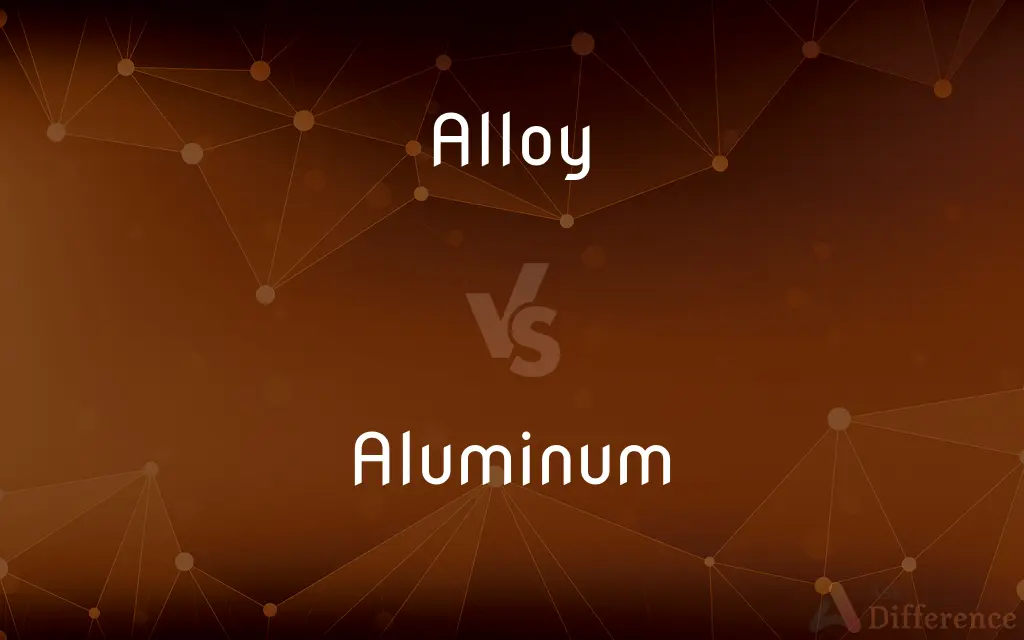Alloy vs. Aluminum — What's the Difference?
By Maham Liaqat & Urooj Arif — Published on April 20, 2024
Alloy is a mixture of metals or a metal combined with one or more elements, enhancing strength or resistance, while aluminum is a lightweight, silvery-white metal known for its corrosion resistance and used widely in alloys.

Difference Between Alloy and Aluminum
Table of Contents
ADVERTISEMENT
Key Differences
Alloys are substances created by melting and mixing two or more elements, at least one of which is metal. This process enhances the base metal's properties, such as strength, ductility, corrosion resistance, or hardness, making alloys more suitable for specific applications than their component materials alone. Common examples include steel (iron and carbon) and brass (copper and zinc).
Aluminum, on the other hand, is an element (with the symbol Al and atomic number 13) known for its low density, high strength-to-weight ratio, excellent corrosion resistance, and electrical conductivity. It's widely used in pure form for packaging, construction, and transportation. However, aluminum's properties can be significantly enhanced by forming alloys with elements like copper, magnesium, and silicon, expanding its range of applications.
The primary difference between an alloy and aluminum lies in their composition and properties. While an alloy is a combination that includes metals and possibly non-metals to improve performance, aluminum is a pure metallic element that can either be used in its unalloyed state or as a base metal in alloy formulations. The choice between using aluminum alone or in an alloy depends on the specific requirements of the application, such as the need for increased strength, temperature resistance, or formability.
Alloys, by their very nature, are designed to meet specific engineering needs by combining the best properties of their constituent elements. For instance, aluminum alloys can achieve greater strength than pure aluminum, making them ideal for aerospace and automotive applications where both strength and light weight are essential. Conversely, pure aluminum is preferred in electrical applications due to its superior conductivity.
Understanding the distinction between aluminum and alloys is crucial in material science and engineering, as it influences material selection in product design and manufacturing. The versatility of aluminum as both a standalone material and a key component in alloys underscores its importance across various industries.
ADVERTISEMENT
Comparison Chart
Composition
Mixture of two or more elements, at least one metal
Pure metallic element (Element symbol: Al)
Characteristics
Properties depend on constituent elements
Lightweight, corrosion-resistant, good conductivity
Uses
Broad, varies by specific alloy (e.g., construction, automotive)
Packaging, construction, electrical, plus alloying
Strength
Can be stronger than base metals alone
Moderate, but improved when alloyed
Corrosion Resistance
Varies, generally enhanced compared to pure metals
Naturally corrosion-resistant, further improved in alloys
Compare with Definitions
Alloy
A substance made by melting together two or more elements to improve strength and corrosion resistance.
Stainless steel, an alloy of iron, chromium, and nickel, is used for cutlery due to its rust resistance.
Aluminum
A lightweight, silvery-white metal known for its corrosion resistance.
Aluminum foil is used for packaging because it's lightweight and resistant to corrosion.
Alloy
Customizable to meet specific engineering needs.
Aerospace alloys are designed for high strength and low weight.
Aluminum
Recyclable without loss of quality.
Recycled aluminum cans are often turned back into new cans.
Alloy
Often stronger than pure metals.
Brass, an alloy of copper and zinc, is stronger and more durable than both its constituent metals.
Aluminum
The base metal in many important alloys.
Aluminum alloys are critical in the construction of aircraft.
Alloy
Designed for enhanced properties like ductility and hardness.
Alloys used in car engines must withstand high temperatures and pressures.
Aluminum
Preferred in construction for its strength-to-weight ratio.
Aluminum is used in window frames for its durability and light weight.
Alloy
Can have varied compositions for different applications.
Bronze, used for statues and bearings, is an alloy of copper and tin.
Aluminum
Used in its pure form for electrical wiring due to excellent conductivity.
High-voltage power lines often use aluminum.
Alloy
A metallic solid or liquid that is composed of a homogeneous mixture of two or more metals or of metals and nonmetal or metalloid elements, usually for the purpose of imparting or increasing specific characteristics or properties
Brass is an alloy of zinc and copper.
Aluminum
A silvery-white, ductile metallic element, the most abundant in the earth's crust but found only in combination, chiefly in bauxite. Having good conductive and thermal properties, it is used to form many hard, light, corrosion-resistant alloys. Atomic number 13; atomic weight 26.9815; melting point 660.32°C; boiling point 2,519°C; specific gravity 2.70; valence 3. See Periodic Table.
Alloy
The relative degree of mixture with a base metal; fineness.
Aluminum
The metallic element forming the base of alumina. This metal is white, but with a bluish tinge, and is remarkable for its resistance to oxidation, and for its lightness, having a specific gravity of about 2.6. Atomic weight 27.08. Symbol Al. Also called aluminium.
Alloy
Something added that lowers value or purity.
Aluminum
A silvery ductile metallic element found primarily in bauxite
Alloy
A metal that is a combination of two or more elements, at least one of which is a metal.
Alloy
Any combination or compound of metals fused together; a mixture of metals; for example, brass, which is an alloy of copper and zinc. But when mercury is one of the metals, the compound is called an amalgam.
Alloy
A mixture containing two or more metallic elements or metallic and nonmetallic elements usually fused together or dissolving into each other when molten;
Brass is an alloy of zinc and copper
Alloy
The state of impairing the quality or reducing the value of something
Common Curiosities
Is aluminum or its alloys more suitable for construction?
It depends on the application; pure aluminum is used for its corrosion resistance and reflectivity, while aluminum alloys are chosen for structural components due to their enhanced strength.
Can aluminum be used as an alloy?
Yes, aluminum serves as a base metal in many alloys, enhancing properties like strength and corrosion resistance when combined with other elements.
What role does aluminum play in sustainability?
Aluminum is highly recyclable, which reduces the need for primary production and lowers its environmental impact.
What are the benefits of using aluminum in alloys?
Aluminum adds lightweight, corrosion resistance, and thermal conductivity to alloys, making them suitable for a wide range of applications.
How is the choice between aluminum and an alloy made for a project?
The choice is based on the project's specific requirements, including strength, weight, corrosion resistance, and cost considerations.
How does the cost of aluminum compare to its alloys?
The cost can vary; pure aluminum may be less expensive than some specialized alloys, which require additional processing and contain costlier elements.
What makes an alloy different from a pure metal like aluminum?
An alloy is a mixture designed to improve upon the properties of its constituent metals, whereas aluminum is a pure element with its own set of characteristics.
Why are alloys often preferred over pure metals in engineering?
Alloys are engineered to meet specific requirements, offering improved strength, corrosion resistance, or other desired properties not found in pure metals.
Are all aluminum products made from alloys?
Not all; some products use pure aluminum for its specific properties, but many are made from alloys to take advantage of improved characteristics.
Can the properties of an alloy be customized?
Yes, by adjusting the composition and manufacturing process, the properties of an alloy can be tailored to specific needs.
Share Your Discovery

Previous Comparison
Labour vs. Conservative
Next Comparison
Accent vs. StressAuthor Spotlight
Written by
Maham LiaqatCo-written by
Urooj ArifUrooj is a skilled content writer at Ask Difference, known for her exceptional ability to simplify complex topics into engaging and informative content. With a passion for research and a flair for clear, concise writing, she consistently delivers articles that resonate with our diverse audience.












































